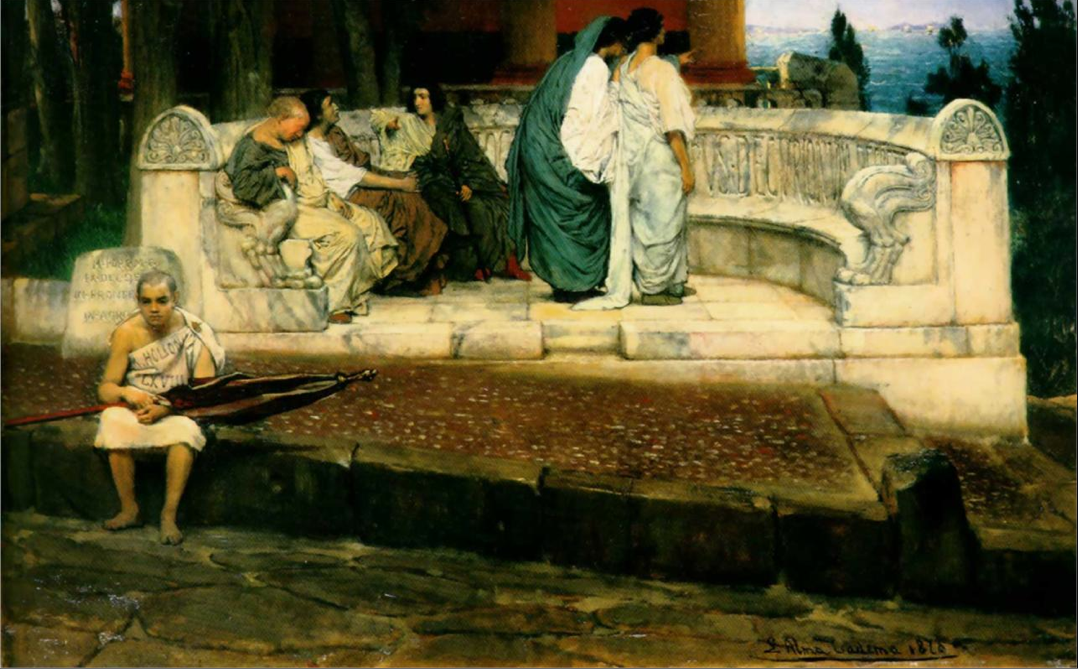Today’s post comes from Stephanie Muir, class of 2015 and Art Center Student Docent.
If you were to make your way to the Art Center’s 19th century galleries today, you would notice that a certain something is different. A definitive work from the Loeb’s permanent collection, An Exedra by Sir Lawrence Alma-Tadema, recently went on loan for the exhibition The Last Days of Pompeii: Decadence, Apocalypse, Resurrection. The exhibition, which will show at the Getty Villa in Malibu, the Cleveland Museum of Art and the Musée national des beaux-arts du Québec, explores modernity’s preoccupation with the ancient city and how this fascination translates into art.
Alma-Tadema, who worked in an academic style, created massively popular works with which the bourgeoisie of the time could identify. An Exedra, painted in 1869, is no exception as the artist’s interpretation of elegant, classical subject matter plays off of Victorian sensibilities. Drawing upon the Tomb of Mamia on the Via dei Sepolcri for inspiration, Alma-Tadema enhances a real setting to make the composition appealing and accessible to modern audiences of both his time and today.
To produce a scene both visually and thematically resonant for viewers, the artist includes a number of significant contrasts. These contrasts create a clear focus within the composition, which in turn guides one’s eye through the narrative. The stark difference between the luminous grey and ivory tones of the exedra (a semi-circular bench), and the darker, earthy colors of the immediate environment places emphasis on the exedra as a primary point of attention. This juxtaposition of color in conjunction with the curved form of the exedra perfectly frames the classical figures in the painting, inviting the viewer to consider their relationships both with one another and their larger surroundings.
The enclosed figures, caught in a candid moment, engage in a wide array of expressions and gestures. They point to objects in the distance, gaze intently at one another in conversation or seem to have nodded off to sleep on the hot, still day. The figure in dark brown robes appears to be caught mid-sentence, frozen in a snapshot of time, while the slave stares directly out of the composition in exhausted apathy. Even though the physical setting may not be immediately recognizable to the viewer, the emotions expressed by the figures and the immediacy with which Alma-Tadema depicts the everyday transcend time through an underlying sense of humanity that permeates the painting and its subject matter.
The spatial arrangement of the composition echoes the class system prevalent during Alma-Tadema’s time. Figures with greater social standing occupy the top half of the picture space as they sit on the exedra, clearly separated from the street. The figure of the slave, however, occupies the bottom half of the composition, sitting alone on the edge of the pavement. The physical elevation of the privileged mirrors the social disparity so ingrained in Victorian society at the time and still present in Western society today. For these reasons, An Exedra by Sir Lawrence Alma-Tadema resonates so well with both Victorian and modern audiences alike, as it embodies and explores both universally human and socially specific values.
For more information on the show at the Getty, check out the exhibition page at http://www.getty.edu/art/exhibitions/pompeii/index.html.






You’re an awesome blogger and I truly liked your current method. Maintain the excellent function!
Your current creating ability are very appealing. Thank you!
I’ve got to go along with your comments over myself. You have accomplished a good work composing this post!